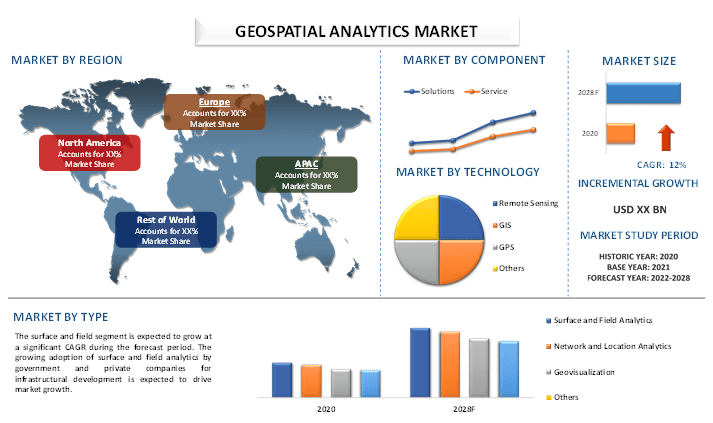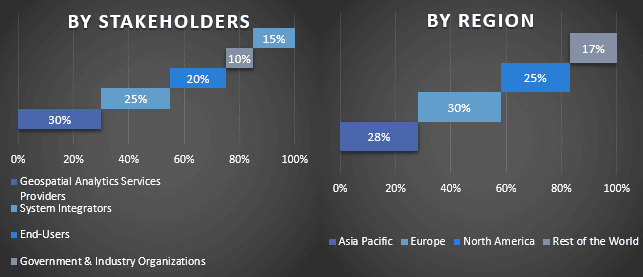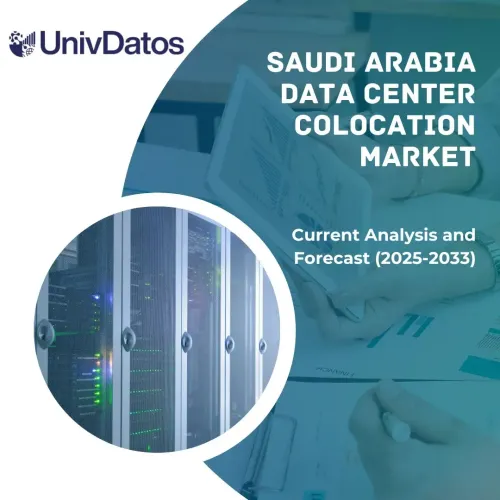- Home
- About Us
- Industry
- Services
- Reading
- Contact Us
Geospatial Analytics Market: Current Analysis and Forecast (2022-2028)
Emphasis on Component (Solutions and Services); Deployment (Cloud and On-Premises); Type (Surface and Field Analytics, Network and Location Analytics, Geovisualization, and Others); Technology (Remote Sensing, GIS, GPS, and others); Industry Vertical (Government, Environmental Monitoring, Defense and Security, and Others) and Region/Country

Global Geospatial Analytics Market is expected to grow at a significant rate of around 12% during the forecast period. Geospatial analytics is used to add timing and location to traditional types of data and to build data visualizations. These visualizations can include maps, graphs, statistics, and cartograms that show historical changes and current shifts.
The growing adoption of geospatial analytics can be attributed to the growing implementation of AI and ML capabilities of geospatial data. Furthermore, the growing number of geospatial analytics service providers is also expected to drive the market. Moreover, location-based services are widely utilized in various different verticals, including retail, mining transportation construction, and urban planning. For instance, in Jan 2020 Esri, a global leader in location technology partnered with Open Systems International to offer utility companies Esri’s ArcGIS utility network management as a part of GIS technology and OSI’s operational technology (OT) platform.
Esri Inc, MDA Corporation, Hexagon AB, TomTom N.V, Trimble Inc, Maxar Technologies Inc, RMSI, Maplarge, General Electric Company, and Bentley Systems are some of the key players in the market. Several M&As along with partnerships have been undertaken by these players to facilitate customers with hi-tech and innovative products/technologies.
Insights Presented in the Report
“Amongst component, solutions category to witness higher CAGR during the forecast period”
Based on component, the market is segmented into solutions and service. The solutions segment is expected to grow with a significant CAGR during the forecast period, owing to the increasing adoption of software solutions by companies for gaining location-based business intelligence for informed decision-making. Furthermore, due to climate change, there has been a significant rise in the adoption of geospatial analytics software in environment monitoring and forest management.
“Amongst type, the surface and field analytics segment is expected to hold a significant share in the market in 2020”
Based on type, the market is segmented into surface and field analytics, network and location analytics, geovisualization, and others. The surface and field segment is expected to achieve a significant CAGR during the forecast period. The growing adoption of surface and field analytics by government and private companies for infrastructural development is expected to drive the market. Furthermore, the growing use of geospatial analytics in agriculture to determine the flow of water, design and construct drainage systems, and analyze topsoil erosion are expected to influence the demand in the segment.
“Amongst technology, the GIS segment is expected to hold a significant share in the market in 2020”
Based on technology, the market is segmented into remote sensing, GIS, GPS, and others. The GIS (geographic information systems) is expected to witness steep growth during the forecast period, owing to the increasing use of GIS in urban planning, disaster management, transport management, and smart city development. Integration of GIS with customer relationship management (CRM) and enterprise resource planning (ERP) has increased the use of GIS for business intelligence and marketing. Furthermore, with the advent of cloud computing and artificial intelligence, the GIS is expected to maintain its growth during the anticipation period.
“Asia Pacific to grow with a significant CAGR during the forecast period”
The Asia Pacific region is expected to grow with a significant CAGR during the forecast period, The growth of geospatial analytics in the region can be attributed to the growing government investments in developing a space-borne – airborne observation systems to improve the national regional, and global in responding to emergencies, and to enhance human health. Furthermore, the region has major developing countries like India and China which have massive defense budgets for research and refinement of the technology.
Reasons to buy this report:
- The study includes market sizing and forecasting Analytics validated by authenticated key industry experts.
- The report presents a quick review of overall industry performance at one glance.
- The report covers in-depth Analytics of prominent industry peers with a primary focus on key business financials, product portfolio, expansion strategies, and recent developments.
- Detailed examination of drivers, restraints, key trends, and opportunities prevailing in the industry.
- The study comprehensively covers the market across different segments.
- Deep dive regional level Analytics of the industry.
Customization Options:
The global geospatial analytics market can further be customized as per the requirement or any other market segment. Besides this, UMI understands that you may have your own business needs, hence feel free to connect with us to get a report that completely suits your requirements.
Table of Content
Research Methodology for the Geospatial Analytics Market Analytics (2022-2028)
Analyzing the historical market, estimating the current market, and forecasting the future market of the global geospatial analytics market were the three major steps undertaken to create and analyze the adoption of Geospatial Analytics in major regions globally. Exhaustive secondary research was conducted to collect the historical market numbers and estimate the current market size. Secondly, to validate these insights, numerous findings and assumptions were taken into consideration. Moreover, exhaustive primary interviews were also conducted, with industry experts across the value chain of the global geospatial analytics market. Post assumption and validation of market numbers through primary interviews, we employed a top-down/bottom-up approach to forecasting the complete market size. Thereafter, market breakdown and data triangulation methods were adopted to estimate and analyze the market size of segments and sub-segments of the industry pertains to. Detailed methodology is explained below:
Analytics of Historical Market Size
Step 1: In-Depth Study of Secondary Sources:
Detail secondary study was conducted to obtain the historical market size of the geospatial analytics market through company internal sources such as annual reports & financial statements, performance presentations, press releases, etc., and external sources including journals, news & articles, government publications, competitor publications, sector reports, third-party database, and other credible publications.
Step 2: Market Segmentation:
After obtaining the historical market size of the geospatial analytics market, we conducted detailed secondary Analytics to gather historical market insights and share for different segments & sub-segments for major regions. Major segments are included in the report as components, types, technology, deployment, and industry vertical. Further country-level analyses were conducted to evaluate the overall adoption of testing models in that region.
Step 3: Factor Analytics:
After acquiring the historical market size of different segments and sub-segments, we conducted detailed factor Analytics to estimate the current market size of the geospatial analytics market. Further, we conducted factor Analytics using dependent and independent variables such as various components, type, technology, deployment, and industry vertical of geospatial analytics. A thorough Analytics was conducted for demand and supply-side scenarios considering top partnerships, mergers and acquisitions, business expansion, and product launches in the geospatial analytics market sector across the globe.
Current Market Size Estimate & Forecast
Current Market Sizing: Based on actionable insights from the above 3 steps, we arrived at the current market size, key players in the global geospatial analytics market, and market shares of the segments. All the required percentage shares split, and market breakdowns were determined using the above-mentioned secondary approach and were verified through primary interviews.
Estimation & Forecasting: For market estimation and forecast, weights were assigned to different factors including drivers & trends, restraints, and opportunities available for the stakeholders. After analyzing these factors, relevant forecasting techniques i.e., the top-down/bottom-up approach were applied to arrive at the market forecast for 2028 for different segments and sub-segments across the major markets globally. The research methodology adopted to estimate the market size encompasses:
- The industry’s market size, in terms of revenue (USD) and the adoption rate of the geospatial analytics market across the major markets domestically
- All percentage shares, splits, and breakdowns of market segments and sub-segments
- Key players in the global geospatial analytics market in terms of products offered. Also, the growth strategies adopted by these players to compete in the fast-growing market
Market Size and Share Validation
Primary Research: In-depth interviews were conducted with the Key Opinion Leaders (KOLs) including Top Level Executives (CXO/VPs, Sales Head, Marketing Head, Operational Head, Regional Head, Country Head, etc.) across major regions. Primary research findings were then summarized, and statistical Analytics was performed to prove the stated hypothesis. Inputs from primary research were consolidated with secondary findings, hence turning information into actionable insights.
Split of Primary Participants in Different Regions

Market Engineering
The data triangulation technique was employed to complete the overall market estimation and to arrive at precise statistical numbers for each segment and sub-segment of the global geospatial analytics market. Data was split into several segments & sub-segments post studying various parameters and trends in the areas of services, types, and applications in the global geospatial analytics market.
The main objective of the Global Geospatial Analytics Market Study
The current & future market trends of the global geospatial analytics market were pinpointed in the study. Investors can gain strategic insights to base their discretion for investments on the qualitative and quantitative Analytics performed in the study. Current and future market trends determined the overall attractiveness of the market at a regional level, providing a platform for the industrial participant to exploit the untapped market to benefit from a first-mover advantage. Other quantitative goals of the studies include:
- Analyze the current and forecast market size of the geospatial analytics market in terms of value (USD). Also, analyze the current and forecast market size of different segments and sub-segments
- Segments in the study include areas of the component, type, technology, deployment, and industry vertical.
- Define and Analytics of the regulatory framework for the Geospatial analytics
- Analyze the value chain involved with the presence of various intermediaries, along with analyzing customer and competitor behaviors of the industry.
- Analyze the current and forecast market size of the geospatial analytics market for the major region.
- Major countries of regions studied in the report include Asia Pacific, Europe, North America, and the Rest of the World.
- Company profiles of the geospatial analytics market and the growth strategies adopted by the market players to sustain in the fast-growing market
- Deep dive regional level Analytics of the industry
Related Reports
Customers who bought this item also bought










